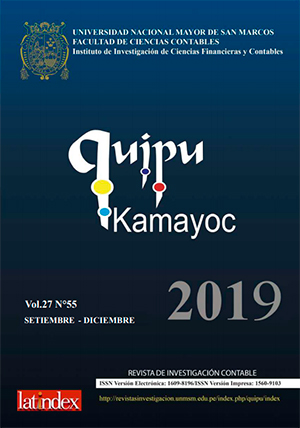Mecanismos de control interno para mejorar los resultados de un programa social: Programa Jóvenes a la Obra
DOI:
https://doi.org/10.15381/quipu.v27i55.16165Palabras clave:
Control, convenio, suscripción, ejecución, optimizaciónResumen
Objetivo: Identificar los mecanismos de control interno que coadyuvan a la mejora de los resultados del Programa Nacional de Empleo Juvenil Jóvenes a la Obra, a través de la ejecución presupuestal, suscripción de convenios y el seguimiento de las tareas programadas. Método: El diseño es no experimental, cualitativo con lo cual se pretende dar respuesta a un fenómeno poco estudiado. Siendo una investigación del tipo descriptivo - explicativo, se elaboraron encuestas para recaudar información pertinente al tema en las que se utilizó la escala de Likert. La recaudación de datos se obtuvo de una población de 80 personas del Programa Jóvenes a la Obra, que laboraron durante el periodo 2014, y para la muestra se utilizó el método del muestreo no probabilístico. Resultados: La implementación de mecanismos de control interno mejorarán los resultados del Programa, optimizando la gestión del mismo. Conclusisón: Los mecanismos de control interno en el marco de la ejecución presupuestal, ejecución de convenios y seguimiento de tareas programadas coadyuvaran a la mejora de la gestión del Programa Jóvenes a la Obra, logrando el incremento de la inserción laboral de los beneficiarios.
Descargas
Publicado
Número
Sección
Licencia
Derechos de autor 2019 Diana Almanza Hurtado

Esta obra está bajo una licencia internacional Creative Commons Atribución-NoComercial-CompartirIgual 4.0.
LOS AUTORES RETIENEN SUS DERECHOS:
a. Los autores retienen sus derechos de marca y patente, y también sobre cualquier proceso o procedimiento descrito en el artículo.
b. Los autores retienen el derecho de compartir, copiar, distribuir, ejecutar y comunicar públicamente el articulo publicado en la revista Quipukamayoc (por ejemplo, colocarlo en un repositorio institucional o publicarlo en un libro), con un reconocimiento de su publicación inicial en la revista Quipukamayoc.
c. Los autores retienen el derecho a hacer una posterior publicación de su trabajo, de utilizar el artículo o cualquier parte de aquel (por ejemplo: una compilación de sus trabajos, notas para conferencias, tesis, o para un libro), siempre que indiquen la fuente de publicación (autores del trabajo, revista, volumen, numero y fecha).






